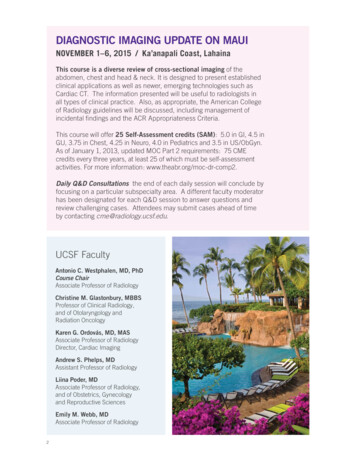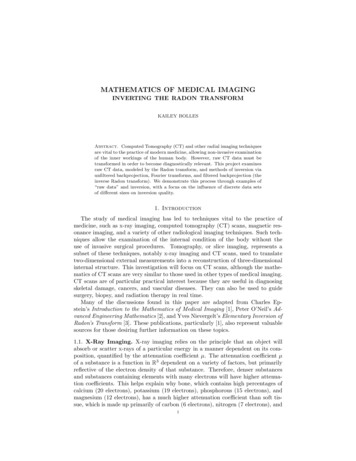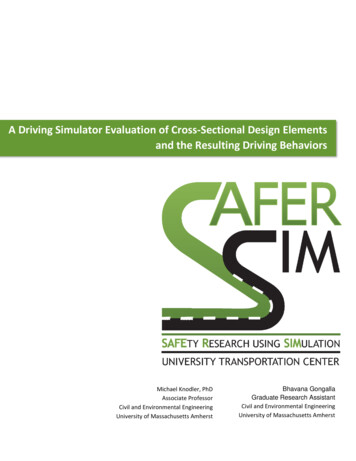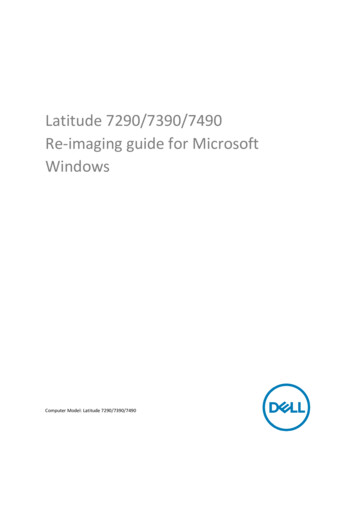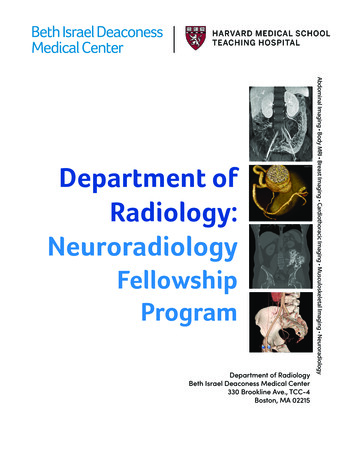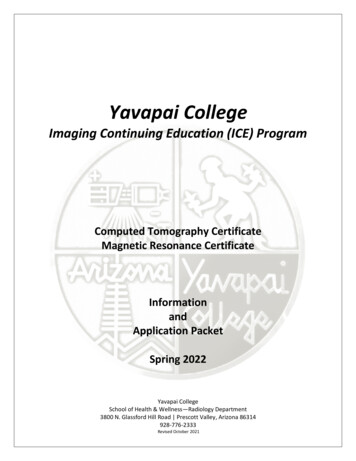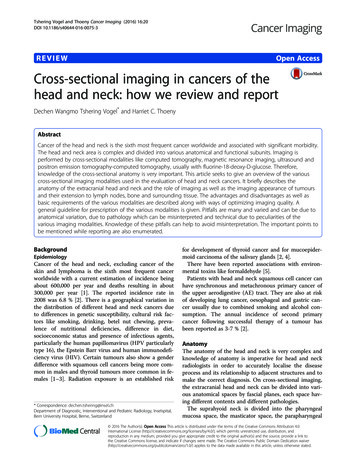
Transcription
Tshering Vogel and Thoeny Cancer Imaging (2016) 16:20DOI 10.1186/s40644-016-0075-3REVIEWOpen AccessCross-sectional imaging in cancers of thehead and neck: how we review and reportDechen Wangmo Tshering Vogel* and Harriet C. ThoenyAbstractCancer of the head and neck is the sixth most frequent cancer worldwide and associated with significant morbidity.The head and neck area is complex and divided into various anatomical and functional subunits. Imaging isperformed by cross-sectional modalities like computed tomography, magnetic resonance imaging, ultrasound andpositron emission tomography-computed tomography, usually with fluorine-18-deoxy-D-glucose. Therefore,knowledge of the cross-sectional anatomy is very important. This article seeks to give an overview of the variouscross-sectional imaging modalities used in the evaluation of head and neck cancers. It briefly describes theanatomy of the extracranial head and neck and the role of imaging as well as the imaging appearance of tumoursand their extension to lymph nodes, bone and surrounding tissue. The advantages and disadvantages as well asbasic requirements of the various modalities are described along with ways of optimizing imaging quality. Ageneral guideline for prescription of the various modalities is given. Pitfalls are many and varied and can be due toanatomical variation, due to pathology which can be misinterpreted and technical due to peculiarities of thevarious imaging modalities. Knowledge of these pitfalls can help to avoid misinterpretation. The important points tobe mentioned while reporting are also enumerated.BackgroundEpidemiologyCancer of the head and neck, excluding cancer of theskin and lymphoma is the sixth most frequent cancerworldwide with a current estimation of incidence beingabout 600,000 per year and deaths resulting in about300,000 per year [1]. The reported incidence rate in2008 was 6.8 % [2]. There is a geographical variation inthe distribution of different head and neck cancers dueto differences in genetic susceptibility, cultural risk factors like smoking, drinking, betel nut chewing, prevalence of nutritional deficiencies, difference in diet,socioeconomic status and presence of infectious agents,particularly the human papillomavirus (HPV particularlytype 16), the Epstein Barr virus and human immunodeficiency virus (HIV). Certain tumours also show a genderdifference with squamous cell cancers being more common in males and thyroid tumours more common in females [1–3]. Radiation exposure is an established risk* Correspondence: dechen.tshering@insel.chDepartment of Diagnostic, Interventional and Pediatric Radiology, Inselspital,Bern University Hospital, Berne, Switzerlandfor development of thyroid cancer and for mucoepidermoid carcinoma of the salivary glands [2, 4].There have been reported associations with environmental toxins like formaldehyde [5].Patients with head and neck squamous cell cancer canhave synchronous and metachronous primary cancer ofthe upper aerodigestive (AE) tract. They are also at riskof developing lung cancer, oesophageal and gastric cancer usually due to combined smoking and alcohol consumption. The annual incidence of second primarycancer following successful therapy of a tumour hasbeen reported as 3-7 % [2].AnatomyThe anatomy of the head and neck is very complex andknowledge of anatomy is imperative for head and neckradiologists in order to accurately localise the diseaseprocess and its relationship to adjacent structures and tomake the correct diagnosis. On cross-sectional imaging,the extracranial head and neck can be divided into various anatomical spaces by fascial planes, each space having different contents and different pathologies.The suprahyoid neck is divided into the pharyngealmucosa space, the masticator space, the parapharyngeal 2016 The Author(s). Open Access This article is distributed under the terms of the Creative Commons Attribution 4.0International License (http://creativecommons.org/licenses/by/4.0/), which permits unrestricted use, distribution, andreproduction in any medium, provided you give appropriate credit to the original author(s) and the source, provide a link tothe Creative Commons license, and indicate if changes were made. The Creative Commons Public Domain Dedication o/1.0/) applies to the data made available in this article, unless otherwise stated.
Tshering Vogel and Thoeny Cancer Imaging (2016) 16:20space, the parotid space, the carotid space, the retropharyngeal space and the perivertebral space includingthe vertebrae (Fig. 1a).The infrahyoid neck spaces consist of the visceralspace including the trachea, esophagus, thyroid andparathyroid glands, the carotid space, the retropharyngeal space and the perivertebral space which extenddownwards from the suprahyoid neck (Fig. 1b).The carotid, perivertebral and retropharyngeal spacesare long vertical spaces extending from the skull baseinto the chest. The retropharyngeal space is a potentialspace bounded anteriorly by the visceral fascia and posteriorly by the prevertebral fascia and extends from thebase of the skull to the posterior mediastinum till aboutthe level of the carina. The perivertebral space includesthe longus colli muscles, the paraspinal muscles, vertebrae, vertebral artery and vein and the spinal cord.Knowledge of these spaces and their displacement patterns help in localisation of the lesions to the variousspaces and facilitates the correct diagnosis. Table 1 contains a list of the various spaces with their contents andthe tumours which can arise in each space. These spacesalso act as potential pathways for spread of disease. Malignant tumours can grow across spaces and are transpatial or tumours can be multispatial in different spacessimultaneously, for example lymphoma and metastases.Furthermore, the head and neck area is divided into several anatomical and functional units, with each having adifferent pattern of tumour spread and T staging (Fig. 2).These include the:(1)The nasal cavity and paranasal sinuses (PNS)(2)The oral cavity and lips, the buccal mucosa, theupper and lower alveolar ridges, retromolar gingiva,floor of the mouth, hard palate and the tongueanterior to the circumvallate papillae(3)The nasopharynx(4)The oropharynx consisting of the soft palateincluding uvula, tonsils, base of the tongue andpharyngeal wallsPage 2 of 15(5)The hypopharynx or laryngopharynx consisting ofthe pyriform sinus, postcricoid area and posteriorhypopharyngeal wall(6)The larynx which is divided into the supraglotticportion (suprahyoid epiglottis with both lingual andlaryngeal surfaces, aryepiglottic folds, arytenoidcartilages, the false vocal cords and the ventricles),the glottis (true vocal cords and the anterior andposterior commissures) and the subglottis whichstarts below the true vocal cords to the inferiormargin of the cricoid(7)The major and minor salivary glands(8)The thyroid glandTumoursTumours can be benign or malignant and can arise fromthe skin, the mucosa, the major and minor salivaryglands, the thyroid, the lymph nodes, the mesenchymaltissues including the bone, cartilage, fibrous tissue, fat,muscles and nerves. They can arise locally or be part ofa systemic malignancy. 90 % of head and neck neoplasms consist of epithelial malignancies of the mucosalmembranes of the upper AE tract called head and necksquamous cell cancer (HNSCC). The second group consists of glandular tumours arising in the major andminor salivary glands and in the thyroid gland. Skin cancer and non-melanoma skin cancer of the head and neckare considered a separate group. Other less frequent tumours include localised lymphoma, sarcomas of boneand soft tissues, and neuroectodermal tumours like paraganglioma, olfactory neuroblastoma, neuroendocrinecarcinoma and malignant melanoma [2]. Very superficiallesions of the mucosa are easily seen clinically, but maynot always be identified on cross-sectional imaging dueto their small volume.Treatment options include surgery, chemotherapy andradiotherapy. Treatment varies according to the type oftumours and their site of origin. We mainly need to detectand localise the tumour and define the extent of spread,the final diagnosis is then made by the pathologist.Fig. 1 Axial T2-weighted images showing the deep spaces of the suprahyoid neck at the level of the oropharynx a and the infrahyoid neck at the levelof the thyroid b which are demarcated by the deep fascia of the neck. The retropharyngeal space is a potential spacebetween the perivertebral space and the pharyngeal mucosa space above and the visceral space below the level of the hyoid bone
Tshering Vogel and Thoeny Cancer Imaging (2016) 16:20Page 3 of 15Table 1 Deep spaces of the neck with contents and tumours which can ariseSpaceContentsTumours1Pharyngeal mucosa spaceMucosa with minor salivary glandsLymphoid tissuePharyngobasilar fasciaLevator and constrictor musclesCartilaginous eustachian tubeSquamous cell carcinoma of pharynxMinor salivary gland tumours, lymphoma2Parapharyngeal spaceFatMinor salivary glandsTrigeminal nerve (V3)Lymph nodesInternal maxillary / ascending pharyngeal arteryLipomas, liposarcomaMinor salivary gland tumoursSchwannomasSoft tissue sarcomaMetastatic lymph nodes3Masticator spaceMuscles of masticationMandibular ramus and bodyInferior alveolar nerveSarcoma of muscle or bone, metastasesLymphomas, direct spread of carcinoma,Minor salivary tumour,4Parotid spaceParotid glandIntraparotid lymph nodesFacial nerve (VII)External carotid artery / retromandibular veinSalivary gland tumours like mucoepidermoidcarcinoma, adenoid cystic cancer etc.Metastatic adenopathyLymphomasOncocytomas, schwannomas, lipomas5Carotid spaceCranial nerves IX-XIISympathetic nervesJugular chain nodesCarotid artery / jugular ic adenopathy6Retropharyngeal spaceLymph nodesFatEctopic salivary gland tissueMetastatic lymphadenopathy, lymphomasSalivary gland tumoursRhabdomyosarcomas7Perivertebral, vertebralVertebraePrevertebrale musclesBlood vesselsParaspinal musclesPhrenic nervePrimary and secondary bone tumoursPlasmacytomaSarcomas, chordomaLymphomasMetastatic lymph nodes8Visceral space (infrahyoid neck)OesophagusThyroid glandsParathyroid glandsTracheaNerves and vesselsSquamous cell carcinomasMinor salivary gland tumoursSarcomasThyroid gland tumoursParathyroid tumoursMetastasesImaging modalitiesThe cross-sectional imaging modalities available includecomputed tomography (CT), magnetic resonance imaging(MRI), ultrasound (US) and positron emission tomographycomputed tomography with fluorine-18-deoxy-D-glucose(18FDG PET-CT). Each modality has its own strengths andweaknesses; these are enumerated below.UltrasoundThis is easily available, entails no radiation, is portable,cheap, has a high resolution and assessment of bloodvessels and tumour vascularity can be performed in realtime without giving contrast media. Intravascular contrast media (SonoVueR) can be given to evaluate enhancement of lesions. Ultrasound is ideal for guidinginterventions where the lesion is well visualised.The disadvantages of ultrasound include operator dependency and the fact that sound waves are not transmitted through bone and air, resulting in nonvisualisation ofstructures behind bones and air collections. Very largelesions can be difficult to evaluate completely and multiplelesions require conscientious documentation.Computerised tomography (CT)This is usually the first modality used because it is widelyavailable, relatively cheap, quick and easy to perform andreproducible. The examination time is short with less motion artefacts than an MR scan. Thin slice, high resolutionimage acquisition allows high quality multiplanar reconstructions with superior evaluation of bony structures andcalcifications. The study can be easily extended to the restof the body for staging purposes. Evaluation of CT imagesis also easier than evaluation of MR images.Disadvantages of CT include radiation exposure,poorer soft tissue contrast compared to MRI, the needto inject iodinated contrast medium to improve contrastwith the risk of contrast induced nephropathy and artefacts due to dental amalgam or orthopaedic material, ifpresent. Contraindications to CT can be absolute or relative and include allergy to contrast media, kidney failure
Tshering Vogel and Thoeny Cancer Imaging (2016) 16:20Page 4 of 15Fig. 2 Sagittal T2-weighted image of the extracranial head and neck showing the division of the anatomical and functional units of the upperaerodigestive tractwith some remaining function, hyperthyroidism, thyroidcancer, bodyweight above 200 kg and inability to liedown. Children are preferentially scanned with MRI orultrasound when feasible to avoid radiation exposure.Magnetic resonance imaging (MRI)This has many advantages: good soft tissue contrast,multiplanar scanning, evaluation of blood vessels without giving contrast media, no radiation exposure, noiodine containing contrast needs to be given. Functionalimaging like diffusion-weighted imaging, perfusion anddynamic enhancement studies can be performed.The main disadvantages include higher costs and longer acquisition time. The investigation is more complexwith many possible sequences which can be performedand evaluation of the images is also more demanding.There are a multitude of potential artefacts (motion artefacts, flow artefacts, field distortion artefacts due tometal or at air bone interfaces or with blood products)which can mimic or obscure pathology. The face, neckand base of the skull have multiple soft tissue, air andbone interfaces with increased chance of susceptibilityartefacts. Additionally movement and swallowing artefacts can degrade image quality. Examination of largerbody areas is limited by longer duration of image acquisition. Gadolinium containing contrast agents should begiven to evaluate tumours and abscesses. Contraindications to the use of gadolinium are absolute or relativeand include previous or pre-existing nephrogenic systemic fibrosis (NSF), previous anaphylactic reaction togadolinium containing contrast agents, patients with aglomerular filtration rate below 30 ml/min/1,73 m2, unstable renal impairment, hepatorenal syndrome orchronic liver function disorders and pregnancy. Therisk-benefit of giving Gadolinium has to be discussedwith the referring physician. Since macrocyclic compounds of gadolinium are known to be more stable thanlinear compounds of gadolinium, they should be preferably given if absolutely necessary.There are also absolute and relative contraindicationsto performing MRI. A body weight over 200 kg precludes an MRI as the table cannot carry this weight.Other contraindications include ferromagnetic metalfragments near vital structures, metal implants in thearea of interest, older pacemakers, nerve stimulators,pumps, cochlear implants and stapes prostheses, claustrophobia, very ill patients, patients who cannot lie downfor long periods of time due to pain or increased risks ofaspiration.Positron emission tomography-computed tomography with fluorine-18-Deoxy-D-Glucose (18FDGPET-CT)The advantages include evaluation of the whole bodyincluding the area of interest, lymph node involvement, detection and exclusion of distant metastasesand the high sensitivity of detection of glucose uptake. One big disadvantage is that it is nonspecific asuptake is also increased in inflammation. It is alsomore expensive, time consuming, requires patient tobe fasting for 6 h, the scanning time is 20–30 minand the total investigation time is about 2–3 h. Thereis some radiation exposure which varies depending onwhether a low dose CT is done for attenuation correction or a diagnostic quality CT is performed. Interpretation can be difficult in areas of complexanatomy, physiological variants and unusual patternsof high FDG- uptake in the head and neck.PET image evaluation is mainly performed by qualitative visual assessment. Visual assessment requires definition of a threshold for judgement of existence anddegree of radiotracer concentration. A semi-quantitativeparameter currently used for PET is the standardised uptake value, which is defined as the tissue concentration
Tshering Vogel and Thoeny Cancer Imaging (2016) 16:20of tracer within a lesion divided by tissue density, asmeasured by PET, divided by the injected dose normalised to patient weight multiplied by a decay factor. Instead of body weight, the injected dose may also becorrected by the lean body mass, or body surface area(BSA). Different tumours also show different glucose uptake and there is no standard threshold value for diagnosis of tumours, however it can be useful for therapymonitoring.Role of imagingClinical examination and endoscopy can visualise tumours in the mucosa of the upper AE tract. However,not all areas are well visualised and submucosal and deeper tumours cannot be seen.The role of imaging lies in the detection or exclusion oftumours, the characterisation of tumours if present andalso to delineate it’s size and extent, to see which structures are involved, whether there is spread to regionallymph nodes, perineural or perivascular spread, bony invasion or in staging examinations, to detect metastases.Imaging is also used for obtaining tissue diagnosis byimage guided biopsies, for planning therapy (radiotherapy, computer assisted surgery), to follow patients undertherapy if necessary, to evaluate response to treatmentallowing change in therapy when possible and aftertreatment, to detect recurrences before it becomes clinically evident to improve chances of successful salvage.Primary imaging (before therapy)CT and MRI are commonly used and provide most of therelevant information when the study parameters are optimised. Information provided by the different modalitiesare usually complementary. The choice of the primary imaging modality depends on what the clinician wants toknow, the available technology, cost factors, reimbursement policies, clinician acceptance and patient factors likepresence of contraindications to MRI (older pacemakers,Page 5 of 15metal fragments, aneurysmal clips) or contraindications tothe use of iodinated contrast media (allergy, renal failure,thyroid cancer). For paediatric patients, radiation exposureis an important factor to consider and therefore MRIshould be performed in children-if available.The ideal initial study is one which is safe and providesall the information required for proper management.This depends on the site of origin of the tumour andknown patterns of spread. The next study, if requiredshould be able to answer questions not clarified by thefirst study.Furthermore, distant metastases or concomitant tumours which can be present due to common risk factorsshould be excluded. This is usually done either by performing a whole body CT or PET-CT. There are increasing reports of PET-MRI, but the availability is limited.Once the presence of a tumour is established, one hasto correctly localise the tumour and identify its extent.Appearance of tumour and tumour extensionTumours appear as asymmetrical thickening of the mucosa (Fig. 3a) or a mass of soft tissue density on CT whichenhances according to its vascularity (Fig. 4a). Larger tumours can show areas of necrosis. On MRI, (Fig. 5a-c) thetumour is usually hyperintense to muscle on T2weighting and hypointense or isointense to muscle on T1weighting. The precontrast T1-weighted images are particularly useful in differentiating tumour from surrounding fat, detecting neurovascular bundle encasement andbone marrow involvement. MRI can overestimate tumourif inflammatory changes and bleeding is present. The useof diffusion-weighted magnetic resonance imaging (DWMRI) can help to better detect and demonstrate tumoursince most squamous cell cancers are relatively hypercellular and can show diffusion impediment. This is especially true and useful in patients who are imaged aftersurgery, where there is surgical change in the anatomyand edema and inflammation due to therapy.Fig. 3 Patient with cancer of the right pyriform sinus. Contrast–enhanced CT scan a showing asymmetrical thickening of the pyriform sinus(arrow) on the right. CT scan at a lower level b showing slight thickening of the posterolateral hypopharyngeal wall (arrowhead) and an adjacentnormal sized lymph node with central necrosis (arrow) indicating metastasis
Tshering Vogel and Thoeny Cancer Imaging (2016) 16:20Page 6 of 15Fig. 4 Patient with an undifferentiated cancer of the right submandibular gland. Contrast–enhanced CT scan a showing the solid, heterogeneouslyenhancing mass on the right side (star). CT scan at a slightly lower level b shows the solid metastatic lymph node (arrow). PET-CT image c showingthe intense uptake of FDG glucose by the tumour (star) and the lymph node metastasis (arrow), both seen at the same level due to difference in thedegree of neck flexionOn PET-CT, the morphological changes due to thetumour are seen as in CT with increased uptake of glucose in those tumours which are FDG avid (Figs. 4c, 5f ),other processes resulting in glucose uptake like inflammation or biopsy will however also show increased uptake and should be excluded when possible.Bony erosion appears as an interruption of the hypointense cortical rim on MR (Fig. 5a-c) or the peripheral,cortical hyperattenuating rim on CT (Fig. 5d,e). Detection of subtle erosions require thin section CT withbone algorithm reconstruction in multiple planes. Sclerosis can be a sign of tumour infiltration or reactive osteitis. Medullary involvement is better detected with MRI.The replacement of normal hyperintense fat signal inthe bone marrow on native T1-weighting with enhancingtissue indicate marrow involvement. Unfortunately,these changes can also be seen in peritumoral edema, inflammation, coexisting periodontal diseases, osteomyelitis, radiation fibrosis and osteoradionecrosis.Perineural spread on CT is diagnosed when there isenlargement or destruction of the respective nerveforamina with replacement of normal fat signal in thesoft tissues (Fig. 6a,b). On MRI, the nerve may bethickened and/or show increased enhancement (Fig. 6a-f).Perineural spread can be antegrade or retrograde andskip lesions can occur. This finding can also be seenFig. 5 Patient with carcinoma ex-pleomorphic adenoma of the submandibular gland on the left with invasion of the mandible. In the T2-weighted MRimage a the lesion is heterogenously hyperintense to muscle and there is loss of the cortical hypointense line indicating bone invasion (arrow). In theT1-weighted image b the lesion is hypointense to the muscle and there is replacement of the normal high signal marrow fat by the tumour. TheT1-weighted image c after injection of gadolinium without fat saturation shows some enhancement of the lesion. Contrast enhanced CT scan at thesame level d shows the heterogenously enhancing mass which extends into the mandible. The cortical bone erosion (arrow) is seen better in the bonewindow setting e. The PET-CT scan f at the same level showing the increased glucose uptake by the tumour with extension into the mandible
Tshering Vogel and Thoeny Cancer Imaging (2016) 16:20Page 7 of 15Fig. 6 Patient with adenoid cystic carcinoma and perineural extension along the inferior orbital nerve, the pteryopalatine fossa and the maxillary nerveon the left side. Contrast enhanced CT images a, b showing the asymmetric thickened enhancing nerve (arrows) on the left. The curved arrow a showsthe normal fat density of the pterygopalatine fossa on the right side. Axial T1-weighted images d, e showing the thickened enhancing nerve (arrows)on the left. Coronal T1-weighted images with fat saturation after injection of gadolinium c showing asymmetrical nerve enhancement (arrow) in thecavernous sinus and f the thickened infraorbital nerve on the left (arrow)in inflammatory changes or due to edema of thenerves. Secondary signs of denervation such as atrophy of the muscles innervated by the involved nerve,or abnormal enhancement of the involved muscles orclinical signs of inflammation can be helpful in thisrespect.PET-CT signs of nerve involvement include linearthickening or linear increased/decreased FDG activityalong the expected course of the cranial nerve. Abnormal activity can be seen in the muscles suppliedby the nerve or increased FDG activity in the synergistic/antagnostic muscles which overcompensate tomaintain function where possible. Other signs likeatrophy and foramen changes are seen on the CTimages [6].Metastases to adjacent Iymph nodes is an importantprognostic factor. We use an image based classification of cervical Iymph nodes described by Som et al.[7], where lymph nodes are divided into seven stations in the neck according to their position. The retropharyngeal, occipital, facial, parotid and mastoidlymph nodes are not included in this classificationand when involved are named according to their anatomical site. Most metastatic nodes are enlarged, atransversal short axis diameter of more than 1.5 cmfor Level II nodes, and more than 1 cm for all othernodes in the neck are considered pathological (Fig. 4b).However, normal sized nodes can have focal areas of necrosis indicating metastases (Fig. 3b). This should be differentiated from the fatty hilus by carefully looking at thenative scans and measuring the Hounsfield units, necrosisalso tends to be central while the hilus is eccentric [8].Other features include increased enhancement, irregularity in shape, heterogeneous enhancement and stranding orobvious infiltration of the adjacent soft tissue whichimply extracapsular spread. Extracapsular spread is animportant finding to be mentioned in the report sinceit is a marker of increased locoregional failure if onlysurgery is performed and chemoradiation should alsobe given.Ultrasound can evaluate the morphology of lymphnodes and Doppler sonography can be used to assess thevascular pattern. Monitoring the lymph node size is alsouseful in the assessment of treatment response. Enlargement of lymph nodes indicates pathology but since reactive lymph nodes also enlarge, it is nonspecific. Around shape with a short to long axes ratio greater than0.5 is a useful pointer, except for submandibular andparotid nodes which can normally be round. Eccentriccortical hypertrophy can indicate focal tumor infiltration. The lymph node border may be smooth or irregular, irregular borders in confirmed metastases indicateextracapsular spread. Loss of the echogenic hilus, necrosis (Fig. 7a) and fine calcification can all be seen in metastases. Normal lymph nodes have hilar vascularity andthe presence of peripheral vascularity in lymph nodes isa useful indicator of malignancy [9] (Fig. 7b). On PETCT metastatic lymph nodes show increased uptake(Fig. 4c).Tumour stagingTumours are classified into stages which determinethe appropriate treatment and prognosis. The unionfor international cancer control (UICC) has published
Tshering Vogel and Thoeny Cancer Imaging (2016) 16:20Page 8 of 15Fig. 7 Lymph node metastasis a in a patient with known multifocal papillary carcinoma of the thyroid showing a small area of necrosis (arrow).Color doppler image showing pathological peripheral vascularity ba staging system UICC TNM classification that is internationally accepted. It is based on the primary tumour sitecharacteristics like size and spread (T), involvement ofIymph nodes (N) and the presence or absence of metastases (M). The use of this standard staging helps in treatment planning, in follow up and allows exchange ofinformation between treatment centres. The anatomicallybased TNM classification considers the local, regional anddistant extension of tumours. Due to the numerous subsites in the head and neck, each with different T staging,readers are referred to the UICC TNM classification ofmalignant tumours [10].N staging of lymph nodes is based on the site, numberand laterality of the lymph nodes relative to the primarytumour site. It does not take into account the presenceof extracapsular spread of tumours or involvement ofretropharyngeal lymph nodes.N staging for most tumours (except the nasopharynxand thyroid)Nx means that the regional lymph nodes cannot beassessedN0 no node involvementN1 single ipsilateral lymph node 3 cm or less ingreatest diameterN2a single ipsilateral lymph node between 3 and 6 cmN2b multiple ipsilateral lymph nodes less than 6 cmN2c contralateral or bilateral lymph nodes lessthan 6 cmN3 any lymph node larger than 6 cm.N staging of nasopharyngeal tumours (midline nodesare considered ipsilateral).N0 no node involvementN1 ipsilateral single lymph node above thesupraclavicular fossa, and/or unilateral or bilateralretropharyngeal lymph node(s), 3 cm or less in greatestdimensionN2a ipsilateral single lymph node between 3 to 6 cmN2b multiple ipsilateral lymph nodes less than 6 cmN2c contralateral or bilateral lymph node(s) 6 cm ingreatest diameter above the supraclavicular fossaN3a lymph node or nodes larger than 6 cm, unilateralor bilateralN3b extension to the supraclavicular fossaN staging for thyroid cancerN1a level VI (pretracheal, paratracheal, prelaryngeal/Delphian lymph nodes)N1b unilateral, bilateral or contralateral cervical (levelI-V), retropharyngeal or superior mediastinal (level VII)nodes.The presence of metastases is another important prognostic factor. M0 means there is no distant metastasisand M1 indicates spread to distant organs beyond theregional nodes.Therapy depends on the tumour type and staging andconsists of surgery and/or chemotherapy and/or radiotherapy. Therefore, the correct diagnosis and adequateassessment of tumour extent is essential for proper therapy of the tumours.Imaging appearance after therapyImaging appearance after therapy depends on the type oftreatment received and this should be known beforeevaluation of images. The expected changes after radiotherapy include ede
Cross-sectional imaging in cancers of the head and neck: how we review and report Dechen Wangmo Tshering Vogel* and Harriet C. Thoeny Abstract Cancer of the head and neck is the sixth most frequent cancer worldwide and associated with significant morbidity. The head and neck area is compl
